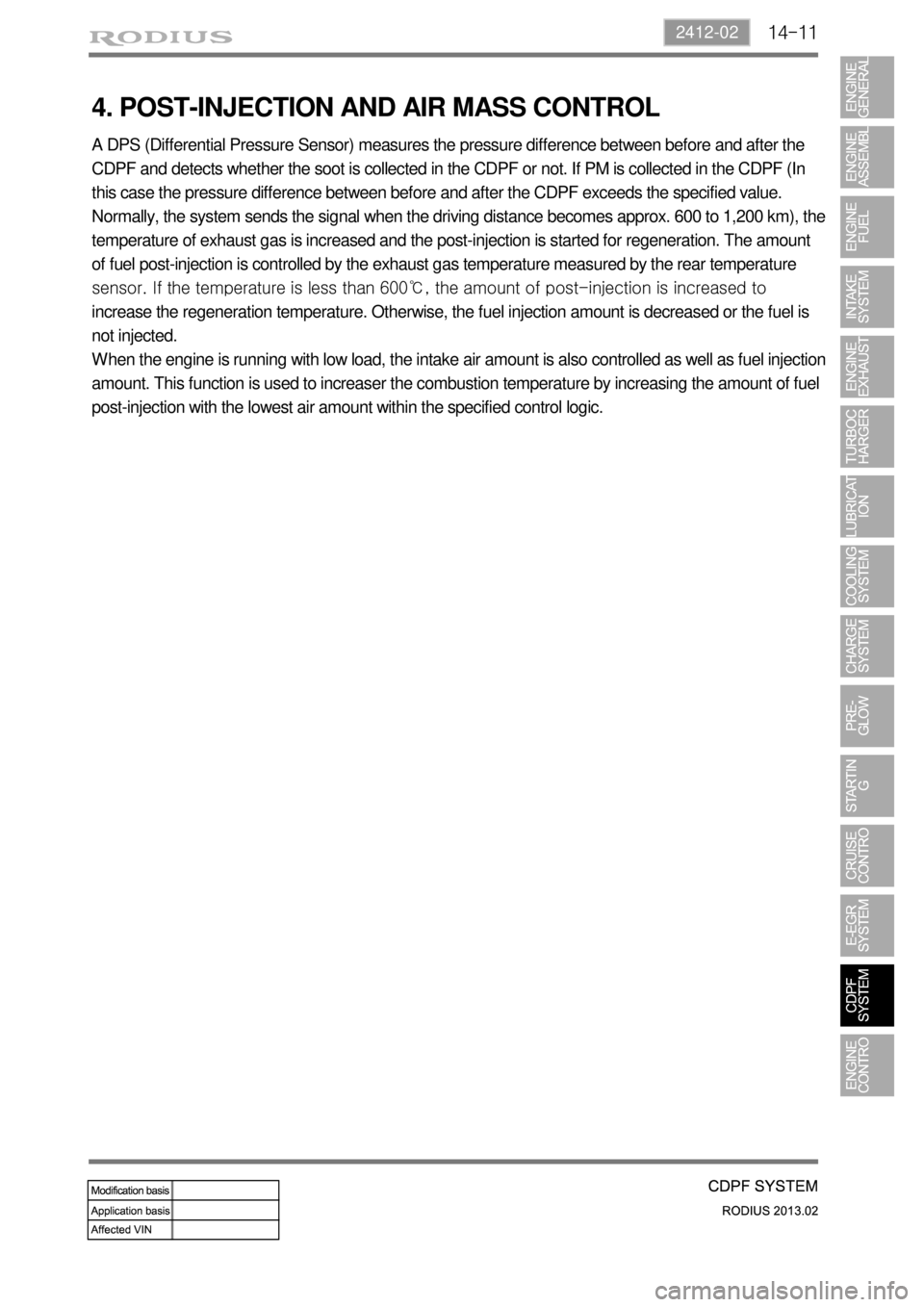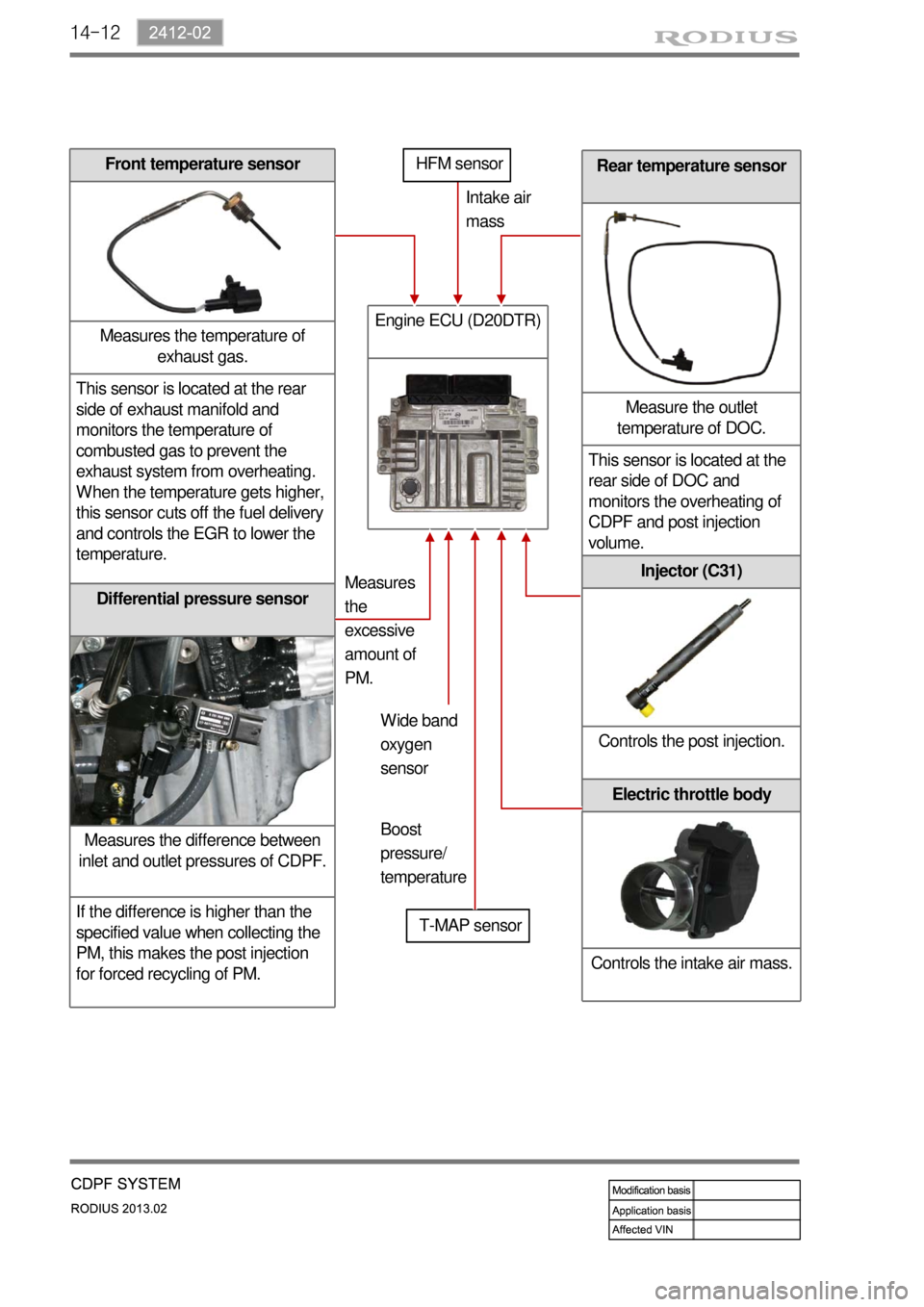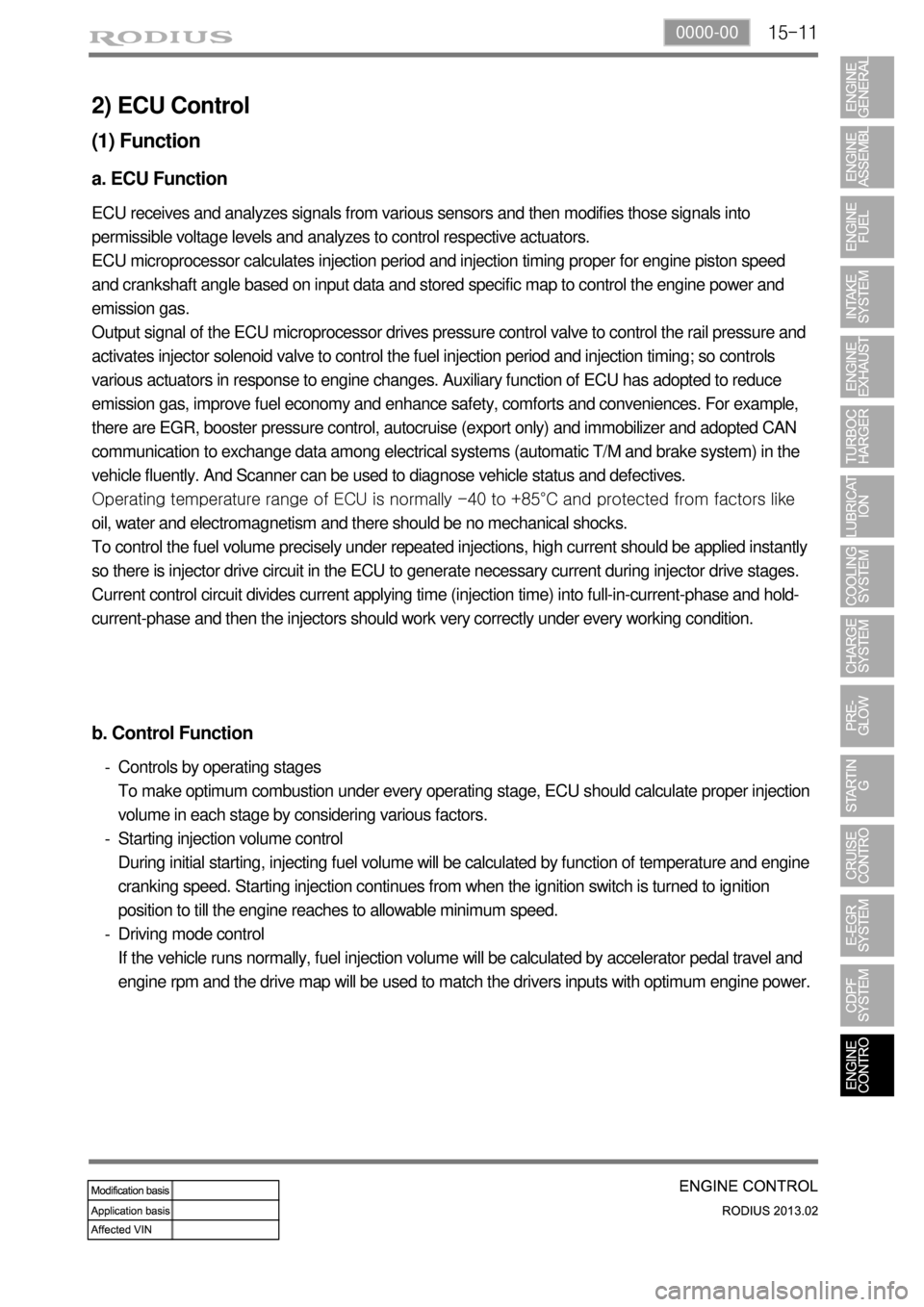2013 SSANGYONG TURISMO Fuel injection
[x] Cancel search: Fuel injectionPage 242 of 796

04-111719-00
LoadEngine
speedSwirl valve Amount of
swirlRemarks
Low speed,
Low loadbelow 3,000
rpmClosed HeavyIncreased EGR ratio, better air-fuel
mixture (reduce exhaust gas)
High speed,
High loadover 3,000
rpmOpen LightIncrease charge efficiency, higher
engine power
The variable swirl valve actuator operates when
turning the ignition switch ON/OFF position to
open/close the swirl valve. In this period, the
soot will be removed and the learning for swirl
valve position is performed.
Swirl: This is the twisted (radial) air flow along the cylinder wall during the intake stroke. This
stabilizes the combustion even in lean air-fuel mixture condition.
Swirl valve
3) Features
Swirl and air intake efficiency
To generate the swirl, the intake port should be serpentine design. This makes the resistance in air
flow. The resistance in air flow in engine high speed decreases the intake efficiency. Eventually, the
engine power is also decreased, Thus, the swirl operation is deactivated in high speed range to
increase the intake efficiency.
Relationship between swirl and EGR
To reduce Nox, it is essential to increase EGR ratio. However, if EGR ratio is too high, the PM also
could be very higher. And, the exhaust gas should be evenly mixed with newly aspired air.
Otherwise, PM and CO are dramatically increased in highly concentrated exhaust gas range and
EGR ratio could not be increased beyond a certain limit. If the swirl valve operates in this moment,
the limit of EGR ratio will be higher. -
-
4) Relationship Between Swirl and Fuel Injection Pressure
The injector for DI engine uses the multi hole design. For this vehicle, there are 8 holes in injector. If the
swirl is too strong, the injection angles might be overlapped and may cause the increased PM and
insufficient engine power. Also, if the injection pressure is too high during strong swirl, the injection
angles might be overlapped. Therefore, the system may decreases the fuel injection pressure when
the swirl is too strong.
Page 318 of 796

14-6
Overload of CDPF
(warning lamp blinking)Excessive overload of CDPF
(warning lamp illuminated)
5) Warning Lamp Related to CDPF
CDPF regeneration process (warning lamp NOT illuminated) ▶
The CDPF system enters the regeneration mode
when the driving distance becomes approx. 600 to
1,200 km (may differ by the driving condition and
driving style). Then, the engine ECU performs the
CDPF regeneration operation. However, the driver
is not informed with this operation by any engine
warning lamp or vehicle signal, so he/she may not
detect this operation. The control logic at the post-
injection dur-ing the regeneration process is to
increase the fuel injection volume and control the
intake air volume (by the throttle body) in order to
increase the temperature of the exhaust gas. The
driver may not feel any particular difference from
the vehicle.
If the CDPF cannot reach the regeneration
temperature due to low speed driving or other
reason during the regeneration process, the soot is
continuously accumulated in the CDPF. W hen this
condition continues and the CDPF is overloaded
with soot, the engine warning lamp blinks to inform
this situation to the driver.
In order to solve this problem, drive the vehicle at a
speed of approx. 80 km/h for 15 to 20 minutes to
perform the CDPF regeneration process.
If the engine warning lamp on the instrument
cluster blinks, the CDPF is overloaded. In this
case, perform the step 2. 1.
2.
3.If the vehicle is driven at a speed of 5 to 10 km/h
for an extended period of time, the soot
accumulated in the CDPF cannot be burned as the
CDPF cannot reach the regeneration temperature.
Then, an excessive amount of soot can be
accumulated in the CDPF.
This case is much worse than the simple over-load
of the CDPF. To inform this to the driver, the
engine warning lamp comes on and the engine
power is decreased to protect the system.
To solve this problem, blow soot between the
engine and exhaust system several times and
erase the related DTC. Then, check if the same
DTC is regenerated again. If so, check the DTC
related to the differential pressure sensor. 1.
2.
3.
OFF
Blinking Illuminating
Blinking Illuminating
Page 322 of 796

14-10
3. INPUT/OUTPUT DEVICES
Front temperature sensor: This sensor is installed at the inlet of DOC and detects whether the
DOC can burn (oxidize) the post-injected fuel or not.
Rear temperature sensor: This sensor is installed at the inlet of DPF and monitors that the
temperature of the exhaust gas is kept at 600℃. 1.
2.
If the temperature exceeds 600℃, the life of CDPF can be reduced. So the amount of fuel
post-injection is decreased.
If the temperature drops under 600℃, the rate of regeneration can be decreased. So the
amount of fuel post-injection is increased. -
-
Differential pressure sensor: This sensor checks the amount of PM collected by calculating the
pressure difference between before and after the CDPF.
Electric throttle valve: This valve reduces the intake air flow to raise the temperature of the exhaust
gas when the CDPF is operating during idling. 3.
4.
Page 323 of 796

14-112412-02
4. POST-INJECTION AND AIR MASS CONTROL
A DPS (Differential Pressure Sensor) measures the pressure difference between before and after the
CDPF and detects whether the soot is collected in the CDPF or not. If PM is collected in the CDPF (In
this case the pressure difference between before and after the CDPF exceeds the specified value.
Normally, the system sends the signal when the driving distance becomes approx. 600 to 1,200 km), the
temperature of exhaust gas is increased and the post-injection is started for regeneration. The amount
of fuel post-injection is controlled by the exhaust gas temperature measured by the rear temperature
sensor. If the temperature is less than 600℃, the amount of post-injection is increased to
increase the regeneration temperature. Otherwise, the fuel injection amount is decreased or the fuel is
not injected.
When the engine is running with low load, the intake air amount is also controlled as well as fuel injection
amount. This function is used to increaser the combustion temperature by increasing the amount of fuel
post-injection with the lowest air amount within the specified control logic.
Page 324 of 796

14-12
Rear temperature sensor
Measure the outlet
temperature of DOC.
This sensor is located at the
rear side of DOC and
monitors the overheating of
CDPF and post injection
volume.
Differential pressure sensor
Measures the difference between
inlet and outlet pressures of CDPF.
If the difference is higher than the
specified value when collecting the
PM, this makes the post injection
for forced recycling of PM.
Front temperature sensor
Measures the temperature of
exhaust gas.
This sensor is located at the rear
side of exhaust manifold and
monitors the temperature of
combusted gas to prevent the
exhaust system from overheating.
When the temperature gets higher,
this sensor cuts off the fuel delivery
and controls the EGR to lower the
temperature.
Engine ECU (D20DTR)
T-MAP sensorIntake air
mass
Measures
the
excessive
amount of
PM.
Injector (C31)
Controls the post injection.
Electric throttle body
Controls the intake air mass.
HFM sensor
Wide band
oxygen
sensor
Boost
pressure/
temperature
Page 327 of 796

14-152412-02
2) Collecting PM of DPF
There is a filter installed in the DPF and the PM filtered by this filter is burned (regeneration) when the
temperature of exhaust gas is increased due to post-injection. The filter has a honeycomb-like
structure to capture the particulate matter and the inlet and outlet of each channel are closed
alternatively. Once the exhaust gas enters to the inlet of a channel, it is released from the outlet of the
adjacent channel through the porous wall because of the closed outlet of the first channel, and the PM
is collected in the first channel.
[Collecting PM of CDPF]
Normally, when the driving distance becomes approx. 600 to 1,200 km, enough amount of soot to
be burned is filtered and accumulated in the CDPF. The ECU increases the amount of fuel post-
injection to increase the temperature of the exhaust gas up to 600°C, so that the soot is
burned. The soot is burned for 15 to 20 minutes (may differ by conditions).
Page 329 of 796

14-172412-02
4) Fuel Injection During CDPF Regeneration
The injection method in D20DTR engine has three steps;
Pilot injection, Main injection, Post injection
Post injection ▶
The post injection is the injection process after main injection and consists of ‘After injection”,
“Post 1 injection” and “Post 2 injection”. All of post injections are to reduce the PM and
harmful exhaust gas. The post injection does not make the actual output. The post injection activates
the fuel by injecting the fuel to the incompletely combusted gas after primary combustion. Through the
process, the PM and smoke in the exhaust gas could be reduced. There are totally 7 injections as
shown in the figure. However, all of 7 injections are not performed during driving because it decreases
the fuel economy. Totally 5 injections can be performed in one cycle.
Page 339 of 796

15-110000-00
2) ECU Control
(1) Function
a. ECU Function
ECU receives and analyzes signals from various sensors and then modifies those signals into
permissible voltage levels and analyzes to control respective actuators.
ECU microprocessor calculates injection period and injection timing proper for engine piston speed
and crankshaft angle based on input data and stored specific map to control the engine power and
emission gas.
Output signal of the ECU microprocessor drives pressure control valve to control the rail pressure and
activates injector solenoid valve to control the fuel injection period and injection timing; so controls
various actuators in response to engine changes. Auxiliary function of ECU has adopted to reduce
emission gas, improve fuel economy and enhance safety, comforts and conveniences. For example,
there are EGR, booster pressure control, autocruise (export only) and immobilizer and adopted CAN
communication to exchange data among electrical systems (automatic T/M and brake system) in the
vehicle fluently. And Scanner can be used to diagnose vehicle status and defectives.
Operating temperature range of ECU is normally -40 to +85°C and protected from factors like
oil, water and electromagnetism and there should be no mechanical shocks.
To control the fuel volume precisely under repeated injections, high current should be applied instantly
so there is injector drive circuit in the ECU to generate necessary current during injector drive stages.
Current control circuit divides current applying time (injection time) into full-in-current-phase and hold-
current-phase and then the injectors should work very correctly under every working condition.
b. Control Function
Controls by operating stages
To make optimum combustion under every operating stage, ECU should calculate proper injection
volume in each stage by considering various factors.
Starting injection volume control
During initial starting, injecting fuel volume will be calculated by function of temperature and engine
cranking speed. Starting injection continues from when the ignition switch is turned to ignition
position to till the engine reaches to allowable minimum speed.
Driving mode control
If the vehicle runs normally, fuel injection volume will be calculated by accelerator pedal travel and
engine rpm and the drive map will be used to match the drivers inputs with optimum engine power. -
-
-